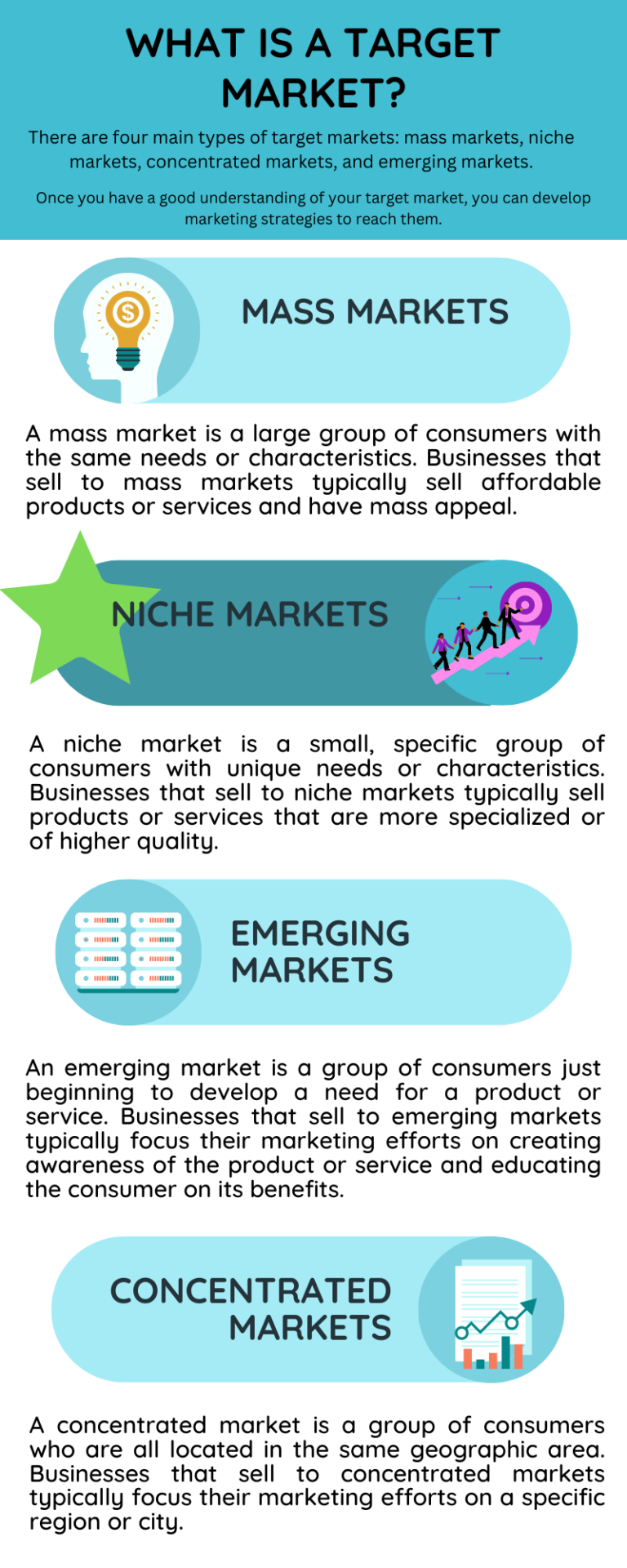The Crucial Role of Target Market Definition in Business Success
Defining your target market is one of the most important things you can do for your business. It helps you focus your marketing efforts, create products and services that meet the needs of your customers, and, ultimately, achieve your business goals.
A target market is a group of people who are most likely to buy your products or services. When you define your target market, you need to consider factors such as age, gender, location, income, interests, and needs.
Once you have a good understanding of your target market, you can develop marketing strategies to reach them. For example, if your target market is young professionals, you might focus your marketing efforts on social media platforms like Facebook and Twitter.
Defining your target market is also important for product development. When you know who your target market is, you can create products and services that meet their needs. For example, if your target market is busy moms, you might develop a line of healthy, convenient meals that they can prepare quickly.
By taking the time to define your target market, you can increase your chances of success in business.
Here are some examples of how businesses have used target market definition to their advantage:
- Netflix: Netflix targets young adults who are looking for a convenient way to watch movies and TV shows. The company offers a subscription service that allows users to stream content on any device, at any time.
- Starbucks: Starbucks targets young professionals who are looking for a place to relax and socialize. The company’s coffee shops are designed to be comfortable and inviting, and they offer a variety of food and drinks that appeal to young professionals.
- Nike: Nike targets athletes of all ages who are looking for high-quality athletic apparel and footwear. The company’s products are designed to help athletes perform at their best, and they are marketed in a way that appeals to athletes’ competitive spirit.
By following these tips, you can define your target market and develop a successful marketing strategy that will help you grow your business.
Here is a set of questions to help you define your target market:
- Who is your ideal customer? Describe their demographics, such as age, gender, location, and income level.
- What are the psychographic characteristics of your target market? Consider their interests, values, attitudes, and lifestyle.
- What are the specific needs, pain points, or challenges that your product or service can address for your target market?
- What are the common behaviors and purchasing patterns of your target market?
- Where does your target market gather information and seek solutions related to your industry or niche?
- Are there any distinct segments within your target market that require tailored marketing approaches?
- Who are your competitors targeting, and is there an opportunity to differentiate and focus on an underserved segment within your market?
- How does your product or service uniquely meet the needs of your target market compared to your competitors?
- What are the communication preferences of your target market? Do they prefer online platforms, social media, or traditional media channels?
- What are the key factors influencing your target market’s buying decisions?
- Are there any seasonal or cyclical trends that affect the purchasing behavior of your target market?
- What are the values and beliefs that resonate with your target market, and how can you align your brand messaging with them?
- How does your target market perceive pricing, and what are their expectations in terms of value for money?
- Are there any geographical considerations or cultural factors that impact your target market’s preferences?
- How can you continually gather feedback and insights from your target market to refine and improve your offerings?
By answering these questions, you can better understand your target market, their needs and preferences, and how your business can effectively cater to them.
The Best Research Methods Used to Understand Customer Needs and Preferences
There are a variety of research methods that can be used to understand customer needs and preferences. These methods can help businesses to define their target market and develop products and services that meet the needs of their customers.
Some of the most common research methods include:
Survey
Surveys are a great way to collect data from many people. Surveys can be used to ask customers about their demographics, needs, preferences, and experiences with a business.
Example: A beauty product company conducted a targeted survey to gain insights into their target market’s preferences for a new skincare line. The survey included questions about customers’ skincare routines, specific concerns, preferred product formats, desired ingredients, and price sensitivity. By analyzing the survey responses, the company discovered that their target market consists primarily of women aged 25-40 with concerns about dry skin and signs of aging. The data revealed a preference for skincare products in cream or serum form, with natural ingredients and a willingness to pay a premium price for high-quality products. Armed with these valuable insights, the company can now develop a skincare line tailored to its target market’s preferences, ensuring customer satisfaction and competitive advantage in the market.
Focus groups
Focus groups are a qualitative research method that involves bringing together a small group of people to discuss a particular topic. Focus groups can be used to get in-depth feedback from customers about their needs, preferences, and experiences with a business.
Example: A software development company conducts focus group research to gather qualitative insights into their target market’s preferences for a new project management tool. Participants, comprising project managers from various industries, engage in an interactive discussion facilitated by the company’s team. The focus group session allows for an in-depth exploration of participants’ experiences, pain points, and desired features related to project management tools. Valuable insights emerge, highlighting the need for intuitive user interfaces, customizable reporting features, seamless integration with existing software platforms, and mobile accessibility. Armed with these qualitative findings, the company gains a clear direction in prioritizing key features and addressing pain points, ensuring the development of a project management tool that precisely meets its target market’s specific needs and preferences. The insights gleaned from the focus group research serve as a vital compass, guiding the company toward creating a solution that resonates with project managers and fosters their success.
Customer interviews
Customer interviews are a qualitative research method involving one-on-one conversations with customers. Customer interviews can be used to get in-depth customer feedback about their needs, preferences, and experiences with a business.
Example: A clothing brand conducts customer interviews to investigate its target market’s preferences and gather qualitative insights. The company gains valuable feedback regarding its clothing line through one-on-one conversations with diverse customers. The interviews cover style preferences, preferred fabrics, color choices, pricing considerations, and overall shopping experiences. Participants are encouraged to provide detailed feedback and suggestions for improvement. Insights gathered from the interviews reveal a strong preference for sustainable fabrics, a desire for inclusive sizing options, and an interest in versatile and timeless designs. Armed with these qualitative findings, the clothing brand can make informed decisions about product development, inventory management, and marketing strategies. In addition, by aligning its offerings with customer preferences, the company can effectively meet the needs of its target market and enhance customer satisfaction, leading to increased loyalty and business growth.
Analytics
Analytics can track customer behavior, such as what pages they visit on a website, what products they purchase, and how often they return to a business. Analytics can identify trends in customer behavior and make informed decisions about product development, marketing, and customer service.
Example: Through the use of analytics, an e-commerce company gains valuable insights into its target market’s online behavior and preferences. The company uncovers key trends and patterns by analyzing website traffic, user engagement, and purchase patterns. The analytics reveal that a significant portion of their target market visits their website from mobile devices, emphasizing the importance of mobile optimization. Furthermore, data indicate that customers frequently browse specific product categories, indicating areas of high interest. By tracking conversion rates and cart abandonment rates, the company identifies potential areas for improvement in the purchasing process. Armed with these quantitative insights, the e-commerce company can make data-driven decisions to optimize their website, enhance user experience, and tailor their marketing strategies. By leveraging the power of analytics, the company can effectively target its marketing efforts, optimize its product offerings, and deliver a seamless online shopping experience that resonates with its target market, resulting in increased conversions and business growth.
By using a variety of research methods, businesses can get a better understanding of their customer’s needs and preferences. This information can be used to define the target market, develop products and services that meet the needs of customers, and improve the customer experience.
Here are some additional tips for using research methods to understand customer needs and preferences:
- Be clear about your goals: What do you hope to achieve by conducting research? Once you know your goals, you can tailor your research methods to collect the necessary data.
- Choose the right research methods: There is no one-size-fits-all approach to research. The best research methods for your business will depend on your goals and your budget.
- Collect data from a variety of sources: The more data you collect, the more accurate your understanding of customer needs and preferences will be.
- Analyze the data carefully: Once you have collected data, you need to analyze it carefully to identify trends and patterns.
- Take action based on the results: The purpose of research is to inform decision-making. Once you have analyzed the data, you need to take action to improve your products, services, and customer experience.
By following these tips, you can use research methods to better understand your customers’ needs and preferences. This information can be used to improve your business and achieve your goals
Conducting Market Research to Identify Your Target Market Characteristics
Once you have gained a thorough understanding of your business, it’s time to dive deeper into market research to identify the characteristics of your target market. Market research allows you to gather valuable data and insights that will help you refine your niche and develop a customer profile that aligns with your business goals.
Start by conducting primary research, which involves directly interacting with your potential customers. This can be done through surveys, interviews, focus groups, or even observing their behavior. Ask questions that explore their preferences, needs, pain points, and buying behaviors. This qualitative
Understanding the Difference Between a Target Market and a Niche
Target market and niche are two important concepts in marketing. A target market is a group of people who have a need for a product or service and are willing to pay for it. A niche is a smaller, more specific segment of a target market.
Here are some of the key differences between target markets and niches:
- Size: Target markets are typically larger than niches.
- Specificity: Niches are more specific than target markets.
- Competition: There is typically less competition in niches than in target markets.
- Marketing efforts: Marketing efforts can be more focused and targeted in niches than in target markets.
When choosing a target market or niche, it is important to consider the following factors:
- The size of the market: Is the market large enough to support your business?
- The specificity of the market: Is the market specific enough that you can reach your target customers?
- The level of competition: Is the market competitive?
- Your marketing resources: Do you have the resources to reach your target market or niche?
By understanding the difference between target markets and niches, you can choose the right market for your business. This will help you to reach your target customers and achieve your marketing goals.
Here are some additional tips for understanding the difference between target markets and niches:
- Do your research. Learn as much as you can about your target market or niche. This includes understanding their demographics, their needs, and their wants.
- Be specific. The more specific your target market or niche, the easier it will be to reach them.
- Be flexible. Your target market or niche may change over time. Be prepared to adapt your marketing strategy as your business grows and evolves.
By following these tips, you can understand the difference between target markets and niches and choose the right market for your business.
Do I Select a Target Market or a Niche?

Whether you need a target market or a niche depends on your business’s goals, resources, and competition. You may want to target a niche market if you are a small business or startup with limited resources. This will allow you to focus your marketing efforts on a smaller group of people and make it easier to reach them.
If you are a large company with deep pockets, you can target a mass market. This will allow you to reach a larger number of people, but it will also be more difficult to tailor your marketing messages to their specific needs and wants.
Ultimately, the decision of whether to target a market or a niche is up to you. Consider your business’s goals, resources, and competition when deciding.
Here are some additional factors to consider when choosing between a target market and a niche:
- Your company’s goals: What are your company’s goals? Are you looking to increase sales, grow market share, or build brand awareness?
- Your company’s resources: How much money, time, and manpower do you have to devote to marketing?
- Your company’s competitive advantage: What makes your company unique? What can you offer your target market that no one else can?
- The target market’s size and growth potential: How big is the target market? How quickly is it growing?
- The target market’s needs and wants: What are the target market’s needs and wants? How can your company meet those needs and wants?
By considering all of these factors, you can choose the right target market or niche for your busines
Benefits of Narrowing Down Your Niche
Narrowing down your niche can provide a lot of benefits for your business. First, it can help you to:
- Focus your marketing efforts: When you have a specific niche, you can focus your marketing efforts on reaching those specific customers. This can help you to save time and money, and it can also help you to get better results.
- Build authority: When you focus on a specific niche, you can become an expert in that area. This can help you to build authority with your target customers, which can lead to more sales and repeat business.
- Charge higher prices: When you are seen as an expert in your niche, you can charge higher prices for your products or services. This is because customers are willing to pay more for the expertise of an expert.
- Stand out from the competition: When you narrow your niche, you will compete against fewer businesses. This can make it easier for you to stand out from the competition and attract customers.
- Increase customer satisfaction: When you focus on a specific niche, you can better understand the needs of your target customers. This can help you provide products or services that meet those needs, leading to increased customer satisfaction.
If you want to grow your business, narrowing down your niche can be a great way to do it. By focusing on a specific market, you can improve your marketing efforts, build authority, charge higher prices, stand out from the competition, and increase customer satisfaction.
Here are some additional tips for narrowing down your niche:
- Do your research: Learn as much as you can about your target market. This includes understanding their demographics, their needs, and their wants.
- Be specific: The more specific your niche, the easier it will be to reach them.
- Be flexible: Your niche may change over time. Be prepared to adapt your marketing strategy as your business grows and evolves.
By following these tips, you can narrow down your niche and build a successful business.
What are you passionate about?
What do you know a lot about?
What are you good at?
What are your skills and talents?
What are your interests and hobbies?
What are your values and beliefs?
What are your goals and dreams?
What are the problems that you are passionate about solving?
Who are the people that you want to help?
What are the needs and wants of your target audience?
Here are 15 questions you can ask yourself to help narrow your niche

What are the pain points of your target audience?
What are the trends in your industry?
Who are your competitors?
What are they doing well?
What could they be doing better?
What is your competitive advantage?
What are your unique selling points?
What is your marketing strategy?
What is your sales strategy?
What is your customer service strategy?
By answering these questions, you can get a better understanding of your passions, skills, and interests. You can also start to identify the problems that you are passionate about solving and the people that you want to help. Once you have a good understanding of these things, you can start to narrow down your niche and find a specific group of people that you can help.
Here are some additional tips for narrowing your niche:
- Be specific. The more specific you can be, the better. For example, instead of saying “I want to help people,” say “I want to help people who are struggling with weight loss.”
- Be realistic. It’s important to be realistic about your skills, talents, and resources. If you’re not an expert in a particular area, it’s probably not a good idea to try to target that niche.
- Be willing to change. Your niche may change over time as you learn more about your target audience and the market. Be willing to adapt and change your niche as needed.
Here are some examples of how businesses have narrowed their niches:
- A personal trainer who specializes in helping people with weight loss.
- A web design company that specializes in designing websites for small businesses.
- A law firm that specializes in helping people with immigration issues.
By narrowing their niches, these businesses have been able to focus their marketing and sales efforts on a specific group of people. This has helped them to reach more customers and generate more sales.
If you’re thinking about starting a business, take the time to narrow your niche. By doing so, you can increase your chances of success.
Real Life Examples of Niche Narrowing
Let’s say you are a web designer. You could choose to target a wide audience, such as all businesses in your city. However, this would be a very competitive market, and it would be difficult to stand out from the crowd.
Instead, you could narrow your niche to a specific type of business, such as yoga studios. This would make it easier to target your marketing efforts and build relationships with potential customers. You could also become an expert in designing websites for yoga studios, making you more valuable to your target audience.
By narrowing your niche, you can increase your chances of success in business.
Here are some additional examples of businesses that have successfully narrowed their niches:
- A bakery specializing in gluten-free cakes: This bakery has carved out a niche by focusing on a specific type of product in high demand.
- A law firm specializing in divorce law: This law firm has narrowed its focus to a specific area of law, allowing it to become an expert in that area.
- A clothing store that specializes sustainably: This clothing store has identified a growing demand for sustainable products and has positioned itself as a leader in this niche.
By narrowing their niches, these businesses have increased their chances of success. If you want to start a business, consider narrowing your niche to a specific target market or area of expertise. This will help you to focus your marketing efforts, build authority, and stand out from the competition.
How to Define Your Target Market
Now that we’ve explored the benefits of narrowing down your niche let’s dive into how to define your target market. You can take several steps to identify your ideal customers and create a marketing strategy that speaks directly to them.
Conducting Market Research for Your Target Market
The first step in defining your target market is to conduct market research for your niche. This research can help you identify the size of your potential market, the needs and pain points of your ideal customers, and the competition within your niche.
Some methods of market research include:
- Surveys and questionnaires: Surveys and questionnaires are a great way to gather quantitative data about your target market. You can ask questions about their demographics, their needs, their pain points, and their purchasing habits.
- Focus groups: Focus groups are a qualitative research method that involves bringing together a small group of people to discuss a particular topic. Focus groups can be used to get in-depth feedback from your target market about their needs, their pain points, and their experiences with your products or services.
- Social media listening: Social media listening is a great way to see what your target market is talking about online. You can use social media listening tools to track mentions of your brand, your competitors, and your industry.
- Competitor analysis: Competitor analysis can help you understand the competition within your niche. You can look at your competitors’ products, services, pricing, marketing strategies, and customer reviews.
- Keyword research: Keyword research can help you identify the terms that your target market is using to search for information about your products or services. You can use keyword research tools to identify high-traffic keywords that you can use in your marketing campaigns.
By conducting market research, you can gather valuable insights that will help you create a more focused and effective marketing strategy.
Identifying Your Ideal Customer
Once you’ve conducted market research for your niche, the next step is to identify your ideal customer. This involves creating a customer persona – a fictional representation of your perfect customer- including demographic, psychographic, and behavioral information.
To create a customer persona, you should consider factors such as:
- Age, gender, and location: Demographic information can help you understand the age, gender, and location of your target market.
- Income and education level: Income and education level can help you understand your target market’s financial resources and educational background.
- Values, interests, and personality traits: Values, interests, and personality traits can help you understand the motivations and interests of your target market.
- Pain points and areas of need: Pain points and areas of need can help you understand the challenges that your target market is facing.
- Online behavior and preferences: Online behavior and preferences can help you understand how your target market interacts with the internet.
By creating a detailed customer persona, you can more effectively tailor your messaging and marketing efforts to your ideal customers.

Developing a Marketing Strategy for Your Niche
Once you’ve identified your ideal customer, the next step is to develop a marketing strategy for your niche. This involves creating messaging and campaigns that speak directly to your target market within your niche, using language and imagery that resonates with their values and interests.
Some tips for developing a marketing strategy for your niche include:
- Creating a unique value proposition: Your unique value proposition (UVP) is what makes your business different from the competition. It should be clear, concise, and easy to understand.
- Using language and imagery that resonates with your target market: Your marketing materials should use language and imagery that resonates with the values and interests of your target market.
- Choosing the right channels to reach your target market: There are many different channels that you can use to reach your target market, such as social media, email marketing, or content marketing. Choose the channels that your target market is most likely to use.
- Creating content that speaks to the pain points and needs of your target market: Your content should be relevant to the needs and interests of your target market. It should also be informative, engaging, and persuasive.
- Measuring and analyzing your results: It’s important to measure and analyze the results of your marketing campaigns to see what’s working and what’s not. This will help you improve your marketing strategy over time.
By developing a marketing strategy that is specifically tailored to your target market within your niche, you can create a more effective and focused approach to marketing.
**An Example of a Value Proposition**
A value proposition is a declaration of the benefit that a company or a product provides to its clients. It must be convincing, straightforward, unambiguous, clear, concise, and persuasive.
Here is an example of a value proposition:
“We help businesses grow by giving them the tools and resources they need to succeed. Our team of experts is dedicated to helping our clients achieve their goals.”
This value proposition is clear, concise, and persuasive. It tells potential customers what the business does, who it serves, and how it can help them.
A value proposition should be based on the following factors:
- The needs of your target audience: What are the problems that your target audience is facing? How can your business solve those problems?
- The unique selling points of your business: What makes your business different from the competition? What value do you offer that no one else does?
- The benefits of your product or service: What are the benefits of using your product or service? How will it make your target audience’s life better?
A well-crafted value proposition can help you attract new customers and grow your business.
Here are some additional tips for writing a value proposition:
- Keep it short and sweet. Your value proposition should be no more than a few sentences long.
- Be specific. Don’t just say that you offer “great customer service.” Instead, say something like “We offer 24/7 customer support by phone, email, and chat.”
- Be persuasive. Your value proposition should make your target audience want to learn more about your business and its products or services.
- Use strong language. Use words like “easy,” “fast,” “reliable,” and “affordable” to describe your products or services.
- Use benefits. Don’t just focus on the features of your products or services. Instead, focus on the benefits that those features will provide to your target audience.
By following these tips, you can write a value proposition that will help you attract new customers and grow your business.
Tips for Reaching Your Target Market
Reaching your target market is essential for any business that wants to succeed. However, it can be challenging to know where to start. Here are some tips to help you reach your target market:
- Define your target market. The first step is to define your target market. Who are you trying to reach? What are their needs and interests? Once you know your target market, you can tailor your marketing efforts to reach them.
- Choose the right channels. There are many different channels that you can use to reach your target market. Some popular channels include social media, email marketing, and content marketing. Choose the channels that your target market is most likely to use.
- Create relevant content. Your content should be relevant to the needs and interests of your target market. It should also be informative, engaging, and persuasive.
- Be consistent. It’s important to be consistent with your marketing efforts. This means creating and publishing content on a regular basis. It also means using the same branding and messaging across all of your channels.
- Measure and analyze your results. It’s important to measure and analyze the results of your marketing campaigns to see what’s working and what’s not. This will help you improve your marketing strategy over time.
You can reach your target market and achieve your marketing goals by following these tips.

Conclusion
In conclusion, defining your target market and narrowing down your niche is an essential step in creating a successful business or marketing strategy. By focusing your resources and efforts on the people who are most likely to buy your products or services, you can create a more effective and targeted approach to marketing, leading to higher levels of revenue and profitability.
Additionally, by understanding your target market and creating products or services that truly solve problems and meet the needs of your ideal customers, you can build long-term relationships with those customers and create a loyal following that will continue to buy from you in the future.
So if you haven’t already, take the time to define your target market and narrow down your niche. It may be the key to unlocking the success you’ve been searching for in your business or marketing efforts.
Here are some key takeaways from this discussion:
- Defining your niche can help you to focus your marketing efforts and resources on a specific market. This can help you to reach more customers and to build stronger relationships with them.
- By focusing on a specific market, you can become an expert in that area. This can give you a competitive advantage over other businesses that are not as specialized.
- By building a strong reputation in your niche, you can attract more customers and to build customer loyalty. This can lead to increased sales and profits.
- By defining your niche, you can increase brand awareness among your target market. This can lead to more customers choosing your business over your competitors.


